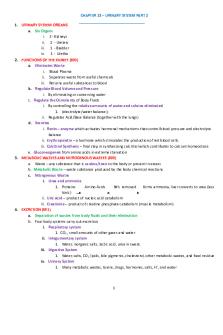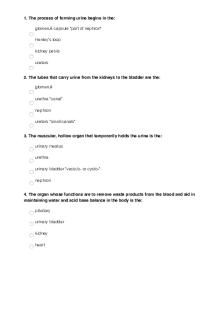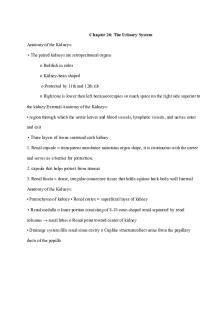The Urinary System-general notes PDF

| Title | The Urinary System-general notes |
|---|---|
| Author | Tolu Oware |
| Course | Biology |
| Institution | High School - Canada |
| Pages | 2 |
| File Size | 86.5 KB |
| File Type | |
| Total Downloads | 73 |
| Total Views | 123 |
Summary
Download The Urinary System-general notes PDF
Description
The Urinary System—general notes -
-
Water from the hypoosmotic side will always move to the hyperosmotic side to maintain an isosmotic gradient (equal rate of flow in both directions); it’s ideal for our cells to be isosmotic with our ECF to maintain homeostasis/ chemical stability Excretion maintains a proper ionic and osmotic equilibrium using the kidney and the bladder to filter blood and excrete waste through the urine (*kidneys are important for maintaining blood pH & fluid balance, and removing waste) Protein promotes cell growth and maintains tissue. Excess protein is converted into carbohydrates (glucose) but it must first be divided into amino acids and then deaminated —the amino group is removed in the liver and then converted into Ammonia (a highly toxic, water soluble gas) which is then excreted as waste in the urine Renal pelvis uses peristalsis to move urine from the kidney to the bladder
Urine and Urine Formation Urine is made from blood; it contains H2O, salt, urea, protein, and acid Glomerular Filtration 1. High pressure blood enters the afferent arteriole and flows into the glomerulus (a bundle of capillaries in the bowman’s capsule); mechanical filtration takes place (filterable blood components enter the glomerulus, and non-filterable components will exit through the efferent arteriole) 2. A mechanical filtration process produces glomerular filtrate (the filterable components of the blood—water, nitrogenous waste—that enter the glomerulus) ***blood cells, platelets, large proteins and lipo-proteins are too large to penetrate the glomerulus walls (non-filterable components) Reabsorption (reduces volume of urine excreted) 1. Aldosterone is secreted, causing Na+ and other molecules seep from the glomerular filtrate through the proximal convoluted tubule walls, and into the ECF; water follows because of osmosis (decreased vol. of filtrate, increased conc.) 2. Cl- follows passively; amino acids and glucose attach to carrier molecules that shuttle them out of the nephron 3. Na+, H2O, and nutrients are reabsorbed by the peritubular capillaries *the proximal tubule is lined with microvilli (+surface area) and mitochondria (+energy) 4. ADH is secreted in the descending loop of Henle, causing water to leave the urine (increasing conc. and decreasing vol.) *thin ascending loop of Henle is highly permeable to Na and Cl but not very permeable to H2O 5. Aldosterone is released in the thick ascending loop of Henle Na+ and Cl- is transported from the urine to the ECF (no reabsorption of H2O b/c walls are impermeable to it) 6. In the distal convoluted tubule nutrients K+ and NaCl) are selectively reabsorbed from the urine into the blood 7. In the collecting duct, H2O leaves the urine into the interstitial fluid, and NaCl is reabsorbed (lesser volume of highly concentrated pee) Secretion 1. Waste moves from the blood into the urine via peritubular capillarycollecting duct* 2. Urine moves to the bladder through the ureter via pelvis (uses peristalsis)
Blood Flow Aortarenal arteryafferent arterioleglomerulus in bowman’s capsuleefferent arterioleperitubular capillariesvenulesrenal veinvena cava Kidney Disorders can be detected via urinalysis Diabetes mellitus is a disorder characterized by the inadequate secretion of insulin or inability of it to be recognized and absorbed into the body cells, resulting in hyperglycemia Individuals with this disorder excrete large volumes of urine with a high glucose concentration, causing them to be thirsty Diabetes Insipidus is a disorder characterized by either a) The destruction of ADH producing cells on the Hypothalamus or b) The destruction of nerve tracts leading from the hypothalamus to the pituitary gland The absence of ADH increases urine output (less reabsorption takes place) and consequently, strong thirst Bright’s Disease, a.k.a. nephritis, is a group of diseases characterized by the inflammation of the nephrons and alterations of osmotic pressure which interferes with urine output One type affects the glomerulus capillaries; it permits proteins and other large molecules to pass through the nephron walls (and because no mechanism is available within the nephron to export them, they remain inside), creating an osmotic pressure that draws water into the nephron, resulting in an increased output of urine Kidney Stones are the result of a precipitation of mineral solutes from the blood that lodge in the pelvis/ureters and tear delicate tissue as the stone moves through the urinary tract (towards the bladder)causing excruciating pain Can be broken apart the stones into smaller particles that are easier to pass using high-energy shock waves Dialysis is the exchange of substances across a semi-permeable membrane; artificial blood filtration—does the kidneys job temporarily when it can’t function a) Hemodialysis is the attachment of a machine to a patients’ circulatory system (via vein); the patients’ blood is pumped through dialysis tubes containing various solutes b) Peritoneal Dialysis is the pumping of dialysis fluid through the abdominal cavity...
Similar Free PDFs

The Urinary System-general notes
- 2 Pages

Urinary System Lecture Notes
- 15 Pages

Urinary
- 10 Pages

Chapter 15 The Urinary System
- 6 Pages

Chapter 9 The Urinary System
- 11 Pages

Anatomy of the Urinary System
- 3 Pages

Urinary system notes, quesion ansers
- 24 Pages

Chapter 26 The Urinary System
- 8 Pages

Ch. 7 Urinary Function Notes
- 10 Pages

Chapter 26 The Urinary System 7
- 3 Pages

Urinary disorder
- 29 Pages
Popular Institutions
- Tinajero National High School - Annex
- Politeknik Caltex Riau
- Yokohama City University
- SGT University
- University of Al-Qadisiyah
- Divine Word College of Vigan
- Techniek College Rotterdam
- Universidade de Santiago
- Universiti Teknologi MARA Cawangan Johor Kampus Pasir Gudang
- Poltekkes Kemenkes Yogyakarta
- Baguio City National High School
- Colegio san marcos
- preparatoria uno
- Centro de Bachillerato Tecnológico Industrial y de Servicios No. 107
- Dalian Maritime University
- Quang Trung Secondary School
- Colegio Tecnológico en Informática
- Corporación Regional de Educación Superior
- Grupo CEDVA
- Dar Al Uloom University
- Centro de Estudios Preuniversitarios de la Universidad Nacional de Ingeniería
- 上智大学
- Aakash International School, Nuna Majara
- San Felipe Neri Catholic School
- Kang Chiao International School - New Taipei City
- Misamis Occidental National High School
- Institución Educativa Escuela Normal Juan Ladrilleros
- Kolehiyo ng Pantukan
- Batanes State College
- Instituto Continental
- Sekolah Menengah Kejuruan Kesehatan Kaltara (Tarakan)
- Colegio de La Inmaculada Concepcion - Cebu




